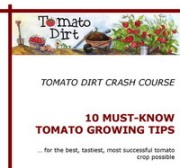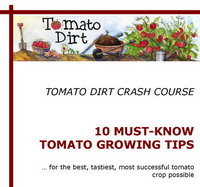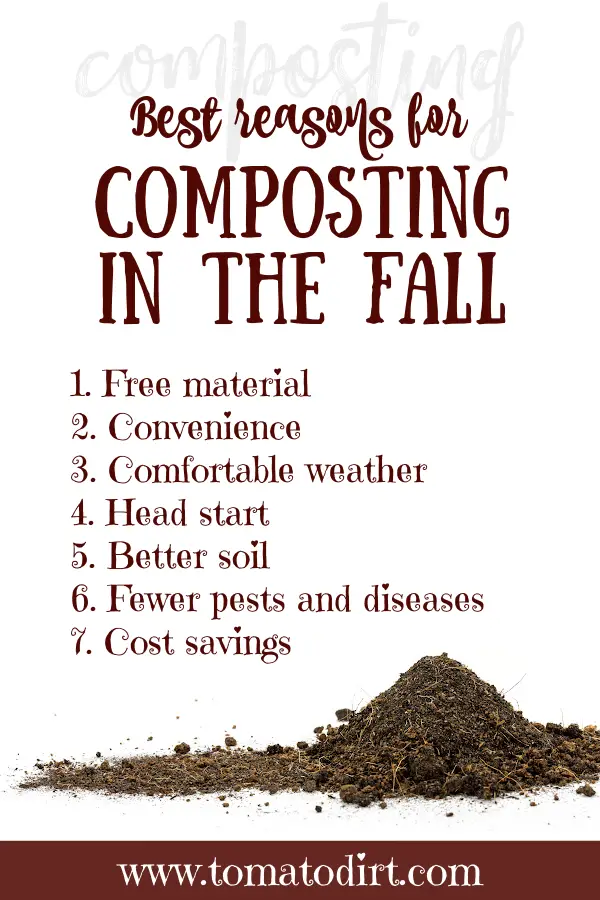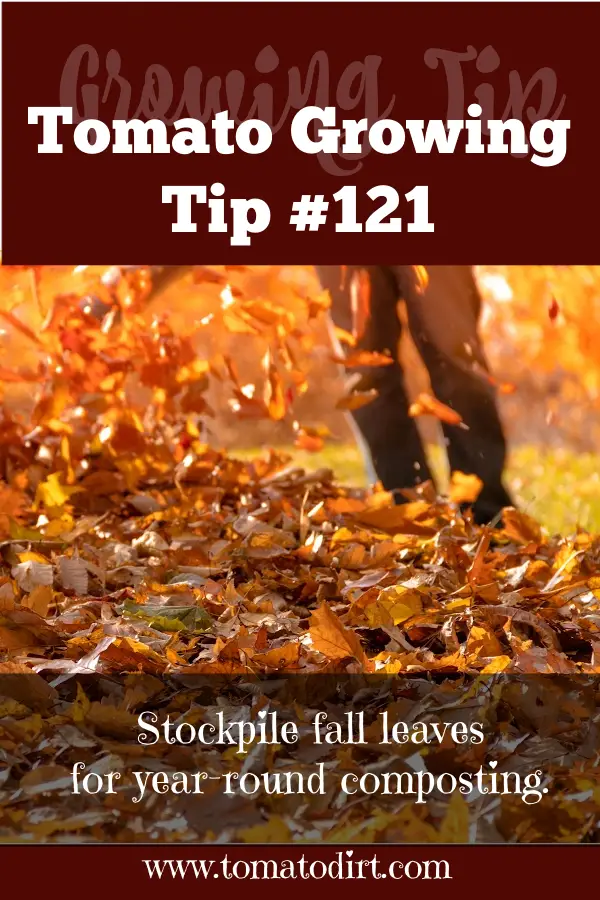FREE: 10 Must-Know Tomato Growing Tips Get The Guide
Read our affiliate disclosure here.
Get Started Composting In The Fall: A Quick Guide
Since 2010, Tomato Dirt has garnered 4.8+ million views, making it the web’s leading online source for growing tomatoes in the home garden. Award-winning writer and Tomato Dirt owner Kathy Widenhouse has helped thousands of home gardeners grow healthier tomatoes. Be one of them when you get Tomato Dirt’s Growing Guide here.
Posted 9.30.25
Your vegetable garden is winding down. Or maybe you’ve put it to sleep for the winter altogether.
But don’t despair, dear gardener. Composting in the fall is an ideal way to keep investing in your garden, even during the off-season. Next spring, when you have plenty of black gold to spread over your vegetable patch, you’ll rejoice that you have the foresight to build your compost pile now.
In fact, fall is one of the best times of year to compost. Here’s why.
Why fall is a perfect time for composting
1. Free material. When you compost in the fall, you’ve got raw material at your fingertips.
The right mixture for compost includes two primary materials, referred to as “greens” (grass clippings, weeds, and kitchen scraps – high in nitrogen) and “browns” (dry leaves and corn stalks – high in carbon). In the fall, you’ve got a perfect “brown” to “green” balance for compost. By weight, the best proportion is about 50% green and 50% brown. Fallen leaves (browns) pair well with fresh grass clippings and pulled-up garden plants (greens). This natural mix gives your compost pile the right carbon-to-nitrogen ratio to break down efficiently.
2. Convenience. You get rid of all those leaves and garden debris in the fall, anyway. It’s the perfect compost fuel. Instead of letting piles of leaves, garden trimmings, and end-of-the-season plants smother your lawn or rot in trash bags, compost them. You’ll keep your yard neat and put waste to good use.
3. Comfortable weather. Turning, shredding, and piling organic matter is easier in crisp fall weather than in the heat of summer.
4. Head start. By composting just as one season closes out, you get a jump start on next year. Building a compost pile in fall gives time for the microbes to work through winter, even if the process slows as temperatures cool. By spring, you’ll have partially (or fully) finished compost ready to enrich planting beds.
5. Better soil. Clear out leftover compost from your current bins in the fall and spread it over your vegetable garden. You’ll give it a chance to incorporate into your soil over winter, feeding soil microbes and improving texture in time for spring. Plus, you’ll have “clean” compost bins to start your fall batch.
6. Fewer pests and diseases. Composting removes spent plants from the garden, where they might encourage diseases, and puts them to better use. Plus, as you clear off your garden surface, pests lose places to hide.
7. Cost savings. By recycling your own garden and kitchen waste, you reduce the need for store-bought soil amendments. You’ll have less to throw out, so you cut down on trips to the landfill, too.
How to get started composting in the fall
Here’s a simple step-by-step guide to get going with composting in the fall.
1. Choose a composting spot or bin
- Select a sunny or partially shaded area with good drainage.
- You can use a compost bin, a tumbler, or make a simple pile.
2. Gather your materials
- Browns (carbon-rich): dry leaves, straw, shredded cardboard, newspaper.
- Greens (nitrogen-rich): grass clippings, vegetable scraps, garden trimmings, coffee grounds.
- Avoid: diseased plants, meat, dairy, oily foods, and pet waste.
3. Layer your pile
- Think of it like making lasagna. Start with a layer of browns at the bottom (helps with airflow).
- Add greens on top.
- Keep alternating layers, finishing with browns to control odor and pests.
4. Keep it moist (but not soggy)
- Your pile should feel like a wrung-out sponge.
- If it’s dry, sprinkle with water.
- If it’s too wet, add more leaves or shredded paper.
5. Turn the pile now and then
- Every few weeks, use a pitchfork or shovel to mix things up. Turning the pile adds oxygen and speeds up decomposition.
6. Let it work through the winter
- The pile will slow down in the cold, but the microbes continue to work inside.
Extra tips for composting in the fall
1. Stockpile leaves for year-round composting
Bag up extra dry leaves in breathable bags (like paper lawn bags or old pillowcases). Store them in a shed or garage—then mix them with food scraps all winter. This way, you won’t run out of “browns” when you need them most, such as when your pile is soggy.
2. Chop it small to speed it up
Run your leaves through a mower or shredder. Break up corn stalks, sunflower stems, and other bulky garden debris. The smaller the pieces, the faster they decompose (sometimes cutting the composting time in half).
3. Use fall veggies to jump-start the pile
Overripe pumpkins, squash, or end-of-season tomatoes make great “activators” because they’re high in nitrogen and moisture. Bury them under a layer of leaves to avoid attracting critters.
4. Don’t let the pile dry out
Fall winds can dry out a compost heap quicker than you’d expect. A dry pile goes dormant. Lightly water layers as you build the pile—especially if leaves are crisp.
5. Add woody stems for airflow
A base of sticks, twigs, or cornstalks keeps the bottom from getting soggy and helps oxygen get through layers. Toss woody bits into the pile here and there to create air channels and reduce the need for constant turning.
6. Invite the winter workers
Even in cold weather, worms and microbes will keep nibbling away. By covering your pile with a tarp that holds heat and moisture, you encourage them to stay active longer into the winter.
7. Pre-load your beds with unfinished compost
In late fall, spread semi-finished compost directly on garden beds. Over winter, frost, snow, and soil life will break it down further. By spring, it’s perfect for planting.
Top tip for composting in the fall
Composting is an aerobic process. It uses oxygen. By combining organic matter, a bit of moisture, and regular turning, you allow oxygen to pass through the layers. As the organic matter breaks down, the compost pile heats up.
You want to give it time to do so.
That’s why the top tip is this: start composting in the fall as early as possible so that your pile can heat up and be active through the colder weather.
Then come spring, you’ll have mounds of luscious black gold to work into your garden, making it a rich, welcoming home for your tomato plants and other crops.
More Composting Tips
When to compost: a guide to composting through 4 seasons...
4 Types of Compost Bins: Which Is Best for You?
How to Compost Tomato Plants ...
Compost Containers For Outside: Which Is Right for You?
2 types of composting for the home gardener ...
How to use a kitchen compost bin to make black gold ...
More composting tips on our Pinterest board ...
Return from Composting in the Fall to Tomato Dirt home
As an Amazon Associate and Rakuten Advertising affiliate I earn from qualifying purchases.
SHARE THIS PAGE:
FREE! 10 Must-Know Tomato Growing Tips: 20-page guide
Get yours here:





